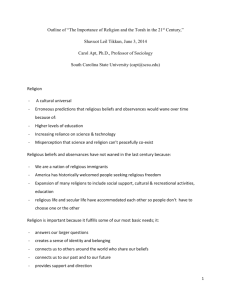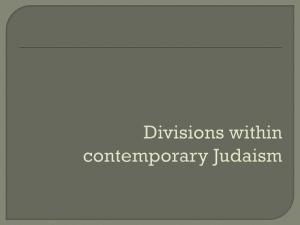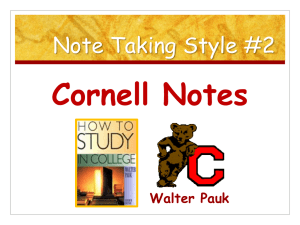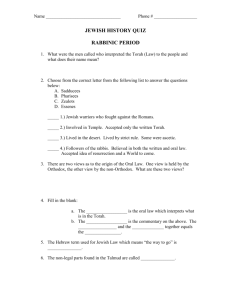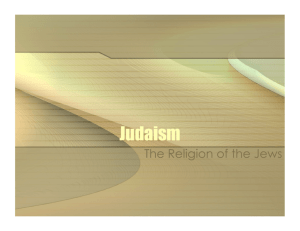7th Grade History (GCP)
advertisement
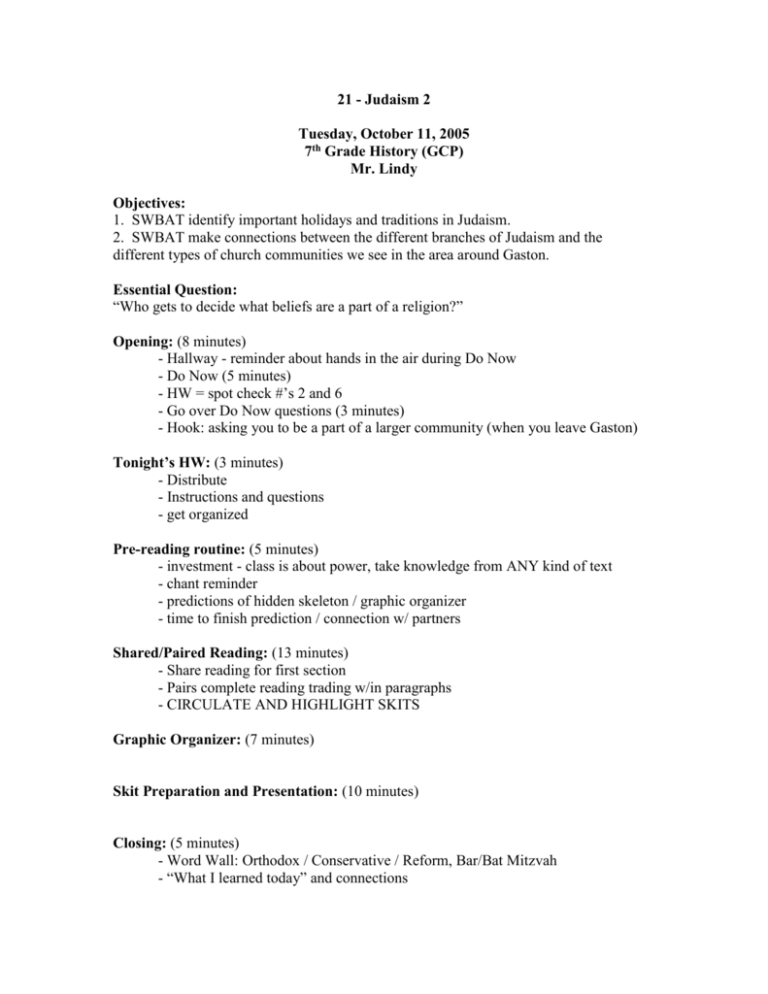
21 - Judaism 2 Tuesday, October 11, 2005 7th Grade History (GCP) Mr. Lindy Objectives: 1. SWBAT identify important holidays and traditions in Judaism. 2. SWBAT make connections between the different branches of Judaism and the different types of church communities we see in the area around Gaston. Essential Question: “Who gets to decide what beliefs are a part of a religion?” Opening: (8 minutes) - Hallway - reminder about hands in the air during Do Now - Do Now (5 minutes) - HW = spot check #’s 2 and 6 - Go over Do Now questions (3 minutes) - Hook: asking you to be a part of a larger community (when you leave Gaston) Tonight’s HW: (3 minutes) - Distribute - Instructions and questions - get organized Pre-reading routine: (5 minutes) - investment - class is about power, take knowledge from ANY kind of text - chant reminder - predictions of hidden skeleton / graphic organizer - time to finish prediction / connection w/ partners Shared/Paired Reading: (13 minutes) - Share reading for first section - Pairs complete reading trading w/in paragraphs - CIRCULATE AND HIGHLIGHT SKITS Graphic Organizer: (7 minutes) Skit Preparation and Presentation: (10 minutes) Closing: (5 minutes) - Word Wall: Orthodox / Conservative / Reform, Bar/Bat Mitzvah - “What I learned today” and connections Name: __________________________________ October 11, 2005 Do Now History - ____ Do Now #29 The Ways People Practice Judaism Objectives: 1. I will be able to identify important holidays and traditions in Judaism. 2. I will be able to make connections between the different branches of Judaism and the different types of church communities we see in the area around Gaston. Essential Question: “Who gets to decide what beliefs are a part of a religion?” 1. We call someone who practices Judaism a _______________. 2. If someone is monotheistic, that person believes in ______________________. 3. If someone is polytheistic, that person believes in _______________________. 4. The name of the holy book for Jews is the _________. It is written on _________________. Directions: Next to each event, write a number (1 through 6) so that each term is in order from oldest to most recent. Abraham ____ Moses _____ Israel (1948) ____ Canonize ____ Torah ____ Exile ____ Directions: Below each picture, list some of the things that makes that picture different from the other picture. _________________________ _________________________ _________________________ _________________________ _________________________ _________________________ _________________________ _________________________ Vocabulary: Orthodox / Conservative / Reform (one card) Above and Beyond: What do the two pictures have in common? Bar/Bat Mitzvah Name: __________________________________ October 11, 2005 Classwork History - ____ Classwork #29 Different Way of Practicing Judaism Branches of Judaism: Just like there are many different kinds of Christians, there are many different kinds of Jews. Think of all the different types of churches you see in the Gaston area. There are Baptists churches, Pentecostal churches, and Methodist churches (to name a few). There are also different types of Jews. The three biggest groups are the orthodox, the reform, and the conservatives. Orthodox Jews: Orthodox Jews believe in following every law in the Torah literally. They believe that it contains words actually spoken by God. They do not believe in figurative readings of the Torah. Orthodox Jews follow very strict laws about what they eat: they do not eat pork or mix meat with milk. They call this keeping kosher. They always wear yalmukas (small hats), and seat men and women separately in synagogue. Women can’t become rabbis. Reform Jews: Reform Jews believe that the Torah contains many valuable ideas but may not be the actual word of God. For this reason, Reform Jews will often read the Torah figuratively. They follow the rules that seem to make sense in modern America but do not worry about certain other laws. Reform Jews allow men and women to sit together in synagogue, and one can choose whether or not one keeps kosher. No one has to wear a yalmuka. Women can become rabbis. Conservative Jews: Conservative Jews are somewhere in the middle. Men and women can sit together in synagogue and choose whether or not to keep kosher. They always pray in Hebrew, however, like the orthodox. Reform Jews pray in Hebrew and in English. Men who are conservative Jews must wear yalmukas. Holidays: The three branches celebrate most of the same holidays. Rosh Hashanah is the Jewish new year. Yom Kippur comes ten days later. On Yom Kippur Jews spend time fasting pray for God to forgive all of their sins from the last year. Channukah comes in the winter near Christmas time. Channukah lasts for eight nights, and Jews often exchange gifts. It celebrates an important victory of the Jews over an enemy. Passover comes in the spring and celebrates Moses leading the Jews out of Egypt to freedom. Life-Cycle Events: The three branches also celebrate many of the same life-cycle events. There are celebrations for births, weddings, and funerals. Each branch has a special ceremony when boys turn thirteen called a Bar Mitzvah. Reform Jews have added a ceremony for girls as well called a Bat Mitzvah. Here, the young person leads the synagogue in prayer, reads from the Torah in Hebrew, and gives an original sermon on the Torah. Directions: Complete the “hidden skeleton” of today’s reading. Directions: Mr. Lindy has highlighted one of the following skit topics below. With your partner, spend five minutes preparing a silent skit on that topic. Your audience needs to be able to figure out which skit your are performing. They will evaluate your performance! 1. A husband and wife entering an Orthodox synagogue 2. Two Reform men entering a synagogue. One wears a yalmuka; one doesn’t 3. A conservative woman who wants to become a rabbi and can’t 4. A very hungry Jewish person praying on Yom Kippur 5. A family exchanging gifts on Channukah 6. A Bar or Bat Mitzvah Evaluate your teammates: Name: Skit #: 1. 2. 3. 4. 5. 6. 7. 8. 9. 10. Confidence: Creativity: Name: __________________________________ October 18, 2005 Homework History - ____ Homework #32 Directions: Write a conversation between two people. One should be a Jew, and the other should be a Christian. Label each person below, and then begin brainstorming. Person #1: ___________________ Person #2: ____________________ Issues about which these two people would disagree: (at least 3) ____________________________ ____________________________ ____________________________ Issues about which these people would agree: (at least 3) ____________________________ ____________________________ ____________________________ Now write a SHORT conversation between these two people. Have each person make two or three comments. Be sure to write in complete sentences. Person #1: _________________________________________________________ _________________________________________________________ Person #2: _________________________________________________________ _________________________________________________________ Person #1: _________________________________________________________ _________________________________________________________ Person #2: _________________________________________________________ _________________________________________________________ (Person #1: _________________________________________________________ _________________________________________________________ Person #1: _________________________________________________________ _________________________________________________________) Vocabulary: Christianity - (n.) a monotheistic religion that believes the Messiah has already come to earth in the form of Jesus Christ. Jesus - (n.) the Messiah (savior) for followers of Christianity Above and Beyond: Continue your conversation on the back of this page.

